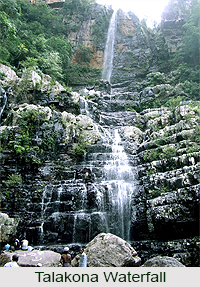 The Talakona Waterfall is in Sri Venkateswara National Park, near the religious city of Tirupati, Andhra Pradesh. It is the highest waterfall in the state.
The Talakona Waterfall is in Sri Venkateswara National Park, near the religious city of Tirupati, Andhra Pradesh. It is the highest waterfall in the state.
Location of Talakona Waterfall
The Talakona Waterfall is situated approximately 49 kilometres from Tirupati, in the Chittoor district of Andhra Pradesh. Positioned in the Sri Venkateswara National Park, the beautiful waterfall cascades deep down into a valley from a cliff on the upper reaches. Talakona Hills are geographically considered a part of the Eastern Ghats. Gushing down from as high as 270 feet (82 metres), the Talakona Waterfall is believed to be the threshold of Tirumala mountain ranges, starting at Seshachalam Hills.
Etymology of Talakona Waterfall
The term "Talakona" is derived from the Telugu words "tala" and "kona", meaning hill and head respectively, allegorically `the head of the Seshachalam hills.
Tourism Relevance of Talakona Waterfall
The Talakona Waterfall enthusiastically contributes to the beauty of the Sri Venkateswara National Park. Placed amidst dense forests, the waterfall offers lush green surroundings and nature"s exquisiteness, with its rich biodiversity. The area was declared a biosphere reserve in the year 1989, owing to its rich flora. It is haven to many different plant species, some of which are extremely rare. It is also home to varied endangered animal species such as Slender Loris, Indian Giant Squirrel, Mouse Deer, Golden Gecko, Panther, Porcupine, Chital and Sambar. Endemic species like Red Sander, Cycas beddomei and Enteda like giant plants are found in the region.
The forest also incorporates some medicinal plants and herbs, through which the waters of the falls flow. Thus the locals believe the water to have immense therapeutic power. It is said that the origin of water is difficult to be traced out since an underground stream suddenly surfaces here.
The site also provides an adventurous range of activities to tourists, from trekking and canopy walking to boating and jungle safari. There are a number of trek routes with different levels of treachery, from which the visitors can choose their own convenient route to trek to the top of the hill. A 240 metres long canopy rope walk, at 35 to 40 feet high, gives visitors a thrilling experience while walking along.
There are also several intriguing caves all over the mountains, which are believed to be spots of perpetual meditation for hermits.
The Talakona Waterfall today, is a popular and charming picnic spot for the people of Andhra Pradesh and Tirupati.
Religious Relevance of Talakona Waterfall
Talakona is known for Lord Siddheswara Swamy temple located close to the waterfall, an ancient temple dedicated to Lord Shiva close to the waterfall, where devotees throng in huge numbers on the festival of Shivarathri.
Accommodations at Talakona Waterfall
There are a good number of log hut and dormitory accommodations for tourists, in the dense forests, giving them an eerie yet delightful atmosphere to spend nights in the woods. Also, there are a number of good private hotels in the city of Tirupati.
Visiting Information for Talakona Waterfall
Talakona Waterfalls can be reached by all 3 convenient means:
By Road: Buses run from nearest town Bakarapeta travelling about 49 kilometres to the falls. It can also be reached from Tirupati by travelling a distance of about 58 kilometres on the Anantapur-Tirupati highway.
By Rail: The nearest railway stations are the Tirupathi Main Railway Station at Tirupati, 58 kilometres from the falls, and the Renigunta Junction distanced 70 kilometres from the falls.
By Air: The nearest airport is the Tirupati Airport at Renigunta in Tirupati, at a distance of 75 kilometres from the falls.
Best Season to visit Talakona Waterfall
The best time to visit Talakona Waterfall is between the months November and January, when the climatic conditions are favourable and water is abundant.






